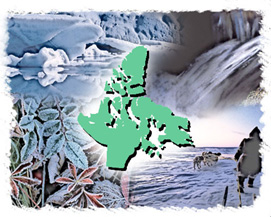| ||||||||||||||||||||||||||||
Proactive disclosure Print version |  Climate Change in Canada Regional Aspects of Climate Change - Nunavut
 Climate change varies greatly within the Canadian North. The west has been warming, with the greatest temperature increases occurring in the winter and spring. The east, however, has experienced a general cooling trend, with the greatest temperature decreases occurring during the winter and spring. Changes in the variability of climate or in the frequency of extremes may be as important to life in Nunavut as long-term warming or cooling trends. Current climate in Nunavut reflects this variability. For southern Nunavut, the winter of 2000 was warmer. However, northern areas along the eastern Arctic Islands were cooler. Also, the precipitation conditions were wetter than normal, which is contrary to the rest of Canada. Summer sea ice conditions vary from year to year. In 1998, the warmest year in Canada since 1951, sea ice extent for the Arctic Islands was a record minimum. The Canadian Arctic is expected to experience more substantial changes than southern regions. In the west, temperature increases of 5°C to 7°C are predicted, whereas in the east, warming is predicted to be much less. Temperature changes will also differ between seasons with more overall warming occurring in the winter months. Potential regional impacts
Curriculum linkages Science Innuuqatigiit curriculum Water - Values: An appreciation of the importance of water to Inuit life should be taught. Ice - Objectives: Understand the relationships between ice, weather, tides current and the land. Key experiences/Activities: Observe salt water and fresh water ice during freeze up and breakup. Notice the differences. How long does it take to freeze, melt, break up? Do they follow a pattern? Is it the same every year? Weather and weather predicting - Values: Recognition that weather controls humans and that humans do not control weather is encouraged. Objectives: Learn about long-term climate changes. Sky - Attitudes: Students will be encouraged to look at the sky and always be conscious of the changing weather; learn from the elders how to read the sky to predict the weather. Bears - Knowledge and traditions: When bad weather prevailed over a long period of time, women would burn a piece of bear skin hoping to change the weather.
|